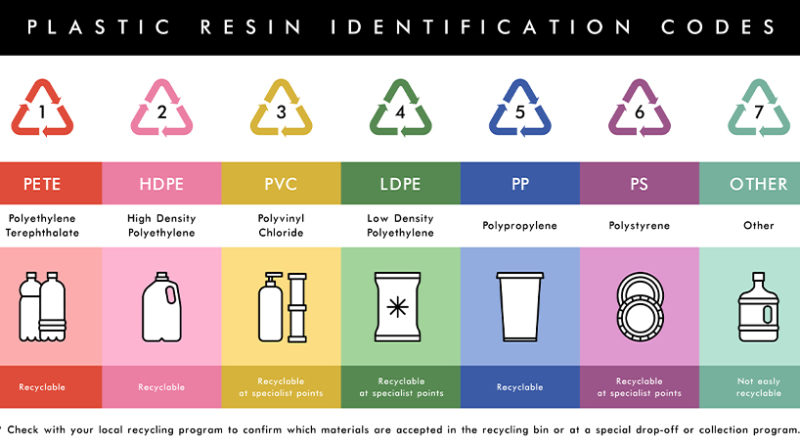Column: Breaking down what’s recyclable, and what’s not
By Amanda Haffele
The chasing arrows symbol was invented in 1970 by Gary Anderson, a 23-year-old college student who won a design contest sponsored by the Container Corporation of America.
The company asked contestants to come up with a symbol that would represent the paper recycling process. Gary’s design won and he was awarded around $2,000 for what he said was “a day or two of work.”
The original theory or idea behind this new symbol was so consumers would know how much—if any—recycled content was in paper products. The paper industry took the original design and created two additional symbols, which are still in use today.
But the industry wasn’t able to get a patent on the original symbol and therefore it became public domain. The popularity of the design spread quickly and became a national symbol to represent recycling.
In 1988, the Society of the Plastics Industry created the Resin Identification Code. This code was invented to aid manufacturers in identifying what type of polymer or plastic was used in the manufacturing process.
The code incorporates the chasing arrows symbol by placing a number within the arrows. You can find the resin identification code on plastic containers, packaging, toys, etc. You may recognize this code on the bottom of soda bottles (#1 plastic) or detergent bottles (#2 plastic).
Years later, the Wisconsin Department of Natural Resources, municipalities, and recycling programs use this code to inform residents on what type of plastic could be collected and recycled, and state laws now require #1 and #2 bottles and jugs to be recycled.
With the invention of new products, shapes, and additives, this identification code no longer tells the whole truth. If you look on the Plastics Make it Possible website, created by the American Chemistry Council, you will see that there are thousands of different types of resins or plastics being used today.
The industry only identifies six resin types on products, with the seventh identified as the “other” category to help identify the remaining resins.
The chasing arrows symbol has brought an awareness to our society about recycling, which is fantastic news: Reduce, Reuse, Recycle.
On the other hand, it has also created a misconception within our society that if an item has a chasing arrows symbol it means that it can or should be recycled when in fact it may not be recyclable at all.
Let’s use squeeze tubes, such as toothpaste and hand lotion, as an example. I have never met or heard of a material recovery facility, or a market that is able to accept, process, and sell squeeze tubes from curbside recyclables. Yet, many squeeze tubes have the chasing arrows symbol embossed somewhere on the container. This is called greenwashing.
Manufacturers think their product can be recycled because it’s made with a certain type of resin, or a small specialty company can recycle it, so they label all their products recyclable, when in fact they’re not recyclable on a large scale.
Not all plastics are created equal. With different ingredients, drying times, processing equipment, and available markets not everything can be recycled.
Contamination is an increasing problem in material recovery facilities—due to the general conscientious among U.S. citizens that, “When in doubt, recycle.”
I, and a few others in my industry, would like to convince you that if you’re unsure if any item can get recycled, err on the side of caution and throw it out, or call your local recycling or waste representative and ask.
As a reminder, only plastic bottles, jugs, and dairy containers are recyclable in your curbside cart in Portage County. All others are trash. Large bulky plastics such as chairs, laundry baskets, kiddie pools, and 5-gallon buckets can be recycled if they are dropped off at the Portage County Material Recovery Facility in Plover. Plastic film and bags can be recycled if they are dropped off at a local grocery or big box store. Neither one of these items can be or will get recycled if they come in with your curbside recyclables.
We love to talk about recycling and proper disposal methods, so please call. You can contact the Portage County Solid Waste Department by calling .715.343.6297.
Amanda Haffele is the Portage County Solid Waste Director. She works at the Material Recovery Facility, 600 Moore Rd., Plover.

